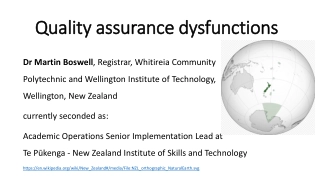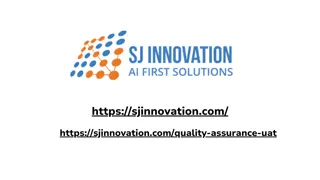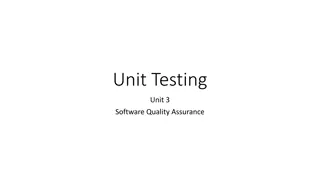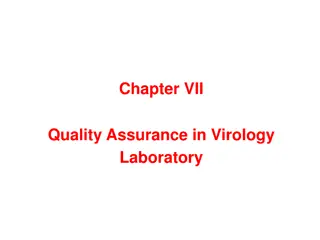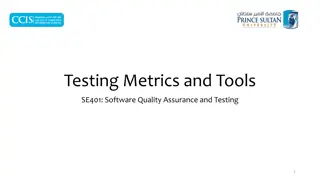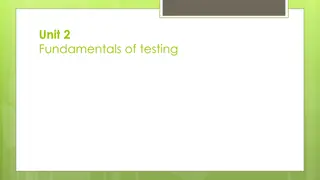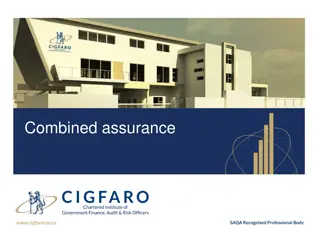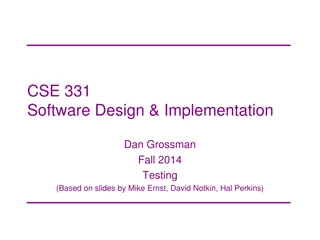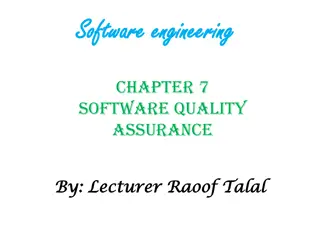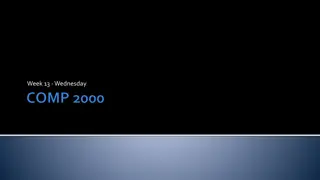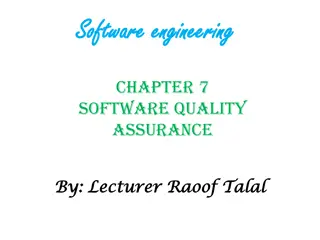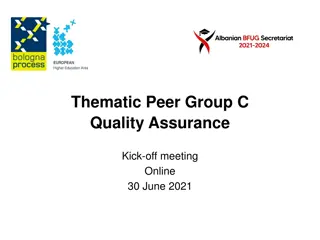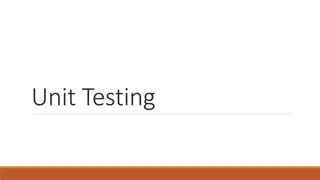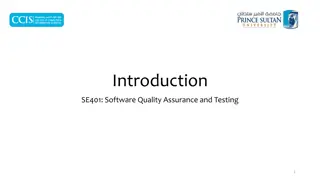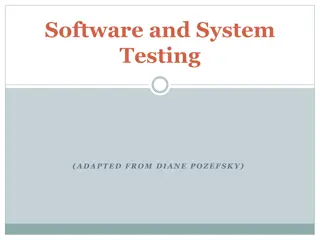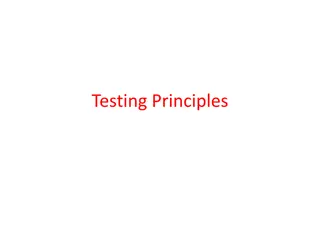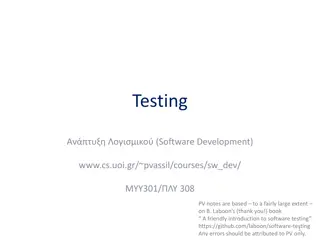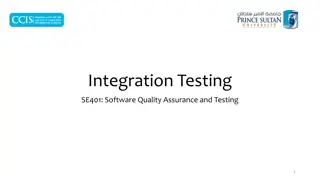SE 433/333 Software Testing & Quality Assurance
Dive into the world of software testing and quality assurance with Dennis Mumaugh in SE 433/333. Explore test plans, fundamental testing questions, and more in this comprehensive lecture series.
Download Presentation

Please find below an Image/Link to download the presentation.
The content on the website is provided AS IS for your information and personal use only. It may not be sold, licensed, or shared on other websites without obtaining consent from the author.If you encounter any issues during the download, it is possible that the publisher has removed the file from their server.
You are allowed to download the files provided on this website for personal or commercial use, subject to the condition that they are used lawfully. All files are the property of their respective owners.
The content on the website is provided AS IS for your information and personal use only. It may not be sold, licensed, or shared on other websites without obtaining consent from the author.
E N D
Presentation Transcript
SE 433/333 Software Testing & Quality Assurance Dennis Mumaugh, Instructor dmumaugh@depaul.edu Office: CDM, Room 428 Office Hours: Tuesday, 4:00 5:30 May 30, 2017 SE 433: Lecture 10 1 of 87
Administrivia Comments and feedback Assignment 1-8 solutions are posted, Assignment 9 on Wednesday Assignments and exams: Assignment 9: Due May 30 Final exam: June 1-7 Take home exam/paper: June 6 [For SE433 students only] Final examination Will be on Desire2Learn. June 1 to June 7 May 30, 2017 SE 433: Lecture 10 2 of 87
SE 433 Class 10 Topics: Test Plans Interview questions: aka Review Statistics and metrics. Miscellaneous Reading: Pezze and Young, Chapters 20, 23, 24 Articles on the Reading List Assignments Assignment 9: Due May 30 Final exam: June 1-7 Take home exam/paper: June 6 [For SE433 students only] May 30, 2017 SE 433: Lecture 10 3 of 87
Thought for the Day Program testing can be a very effective way to show the presence of bugs, but is hopelessly inadequate for showing their absence. Edsger Dijkstra May 30, 2017 SE 433: Lecture 10 4 of 87
Fundamental Questions in Testing When can we stop testing? Test coverage What should we test? Test generation Is the observed output correct? Test oracle How well did we do? Test efficiency Who should test your program? Independent V&V May 30, 2017 SE 433: Lecture 10 5 of 87
Test Plans The most common question I hear about testing is How do I write a test plan? This question usually comes up when the focus is on the document, not the contents It s the contents that are important, not the structure Good testing is more important than proper documentation However documentation of testing can be very helpful Most organizations have a list of topics, outlines, or templates May 30, 2017 SE 433: Lecture 10 6 of 87
Test Plan Objectives To create a set of testing tasks. Assign resources to each testing task. Estimate completion time for each testing task. Document testing standards. May 30, 2017 SE 433: Lecture 10 7 of 87
Good Test Plans Developed and Reviewed early. Clear, Complete and Specific Specifies tangible deliverables that can be inspected. Staff knows what to expect and when to expect it. Realistic quality levels for goals Includes time for planning Can be monitored and updated Includes user responsibilities Based on past experience Recognizes learning curves May 30, 2017 SE 433: Lecture 10 8 of 87
Standard Test Plan ANSI / IEEE Standard 829-1983 is ancient but still used: Test Plan A document describing the scope, approach, resources, and schedule of intended testing activities. It identifies test items, the features to be tested, the testing tasks, who will do each task, and any risks requiring contingency planning. Many organizations are required to adhere to this standard Unfortunately, this standard emphasizes documentation, not actual testing often resulting in a well documented vacuum May 30, 2017 SE 433: Lecture 10 9 of 87
Test Planning and Preparation Major testing activities: Test planning and preparation Execution (testing) Analysis and follow-up Test planning: Goal setting Overall strategy Test preparation: Preparing test cases & test suite(s) (systematic: model-based; our focus) Preparing test procedure May 30, 2017 SE 433: Lecture 10 10 of 87
Test Planning: Goal setting and strategic planning Goal setting Quality perspectives of the customer Quality expectations of the customer Mapping to internal goals and concrete (quantified) measurement. Example: customer's correctness concerns => specific reliability target Overall strategy, including: Specific objects to be tested. Techniques (and related models) to use. Measurement data to be collected. Analysis and follow-up activities. Key: Plan the whole thing"! May 30, 2017 SE 433: Lecture 10 11 of 87
The test plan Allocate resources affects specific models and techniques chosen simple models based on checklists and partitions require less resources Generic steps and activities in test model construction information source identification and data collection (in-field or anticipated usage? code?) analysis and initial model construction model validation and incremental improvement May 30, 2017 SE 433: Lecture 10 12 of 87
Types of Test Plans Mission plan tells why Usually one mission plan per organization or group Least detailed type of test plan Strategic plan tells what and when Usually one per organization, or perhaps for each type of project General requirements for coverage criteria to use Tactical plan tells how and who One per product More detailed Living document, containing test requirements, tools, results and issues such as integration order May 30, 2017 SE 433: Lecture 10 13 of 87
Test documentation May 30, 2017 SE 433: Lecture 10 14 of 87
Test documentation Test plans Outline how your application will be tested in detail Test Plan What: a document describing the scope, approach, resources and schedule of intended testing activities; identifies test items, the features to be tested, the testing tasks, who will do each task and any risks requiring contingency planning; Who: Software Testing; When: (planning)/design/coding/testing stage(s); May 30, 2017 SE 433: Lecture 10 15 of 87
Test documentation Test Plan (cont d) Why: Divide responsibilities between teams involved; if more than one Software Testing team is involved (i.e., manual / automation, or English / Localization) responsibilities between Software Testing teams ; Plan for test resources / timelines ; Plan for test coverage; Plan for OS / DB / software deployment and configuration models coverage. Software Testing role: Create and maintain the document; Analyze for completeness; Have it reviewed and signed by Project Team leads/managers. May 30, 2017 SE 433: Lecture 10 16 of 87
Test documentation Test Case What: a set of inputs, execution preconditions and expected outcomes developed for a particular objective, such as exercising a particular program path or verifying compliance with a specific requirement; Who: Software Testing; When: (planning)/(design)/coding/testing stage(s); Why: Plan test effort / resources / timelines; Plan / review test coverage; Track test execution progress; Track defects; Track software quality criteria / quality metrics; Unify Pass/Fail criteria across all testers; Planned/systematic testing vs. Ad-Hoc. May 30, 2017 SE 433: Lecture 10 17 of 87
Test documentation Test Case (cont d) Five required elements of a Test Case: ID unique identifier of a test case; Features to be tested / steps / input values what you need to do; Expected result / output values what you are supposed to get from application; Actual result what you really get from application; Pass / Fail. May 30, 2017 SE 433: Lecture 10 18 of 87
Test documentation Test Case (cont d) Optional elements of a Test Case: Title verbal description indicative of test case objective; Goal / objective primary verification point of the test case; Project / application ID / title for TC classification / better tracking; Functional area for better TC tracking; Bug numbers for Failed test cases for better error / failure tracking (ISO 9000); Positive / Negative class for test execution planning; Manual / Automatable / Automated parameter etc. for planning purposes; Test Environment. May 30, 2017 SE 433: Lecture 10 19 of 87
Test documentation Test Case (cont d) Inputs: Through the UI; From interfacing systems or devices; Files; Databases; State; Environment. Outputs: To UI; To interfacing systems or devices; Files; Databases; State; Response time. May 30, 2017 SE 433: Lecture 10 20 of 87
Test documentation Test Case (cont d) Format follow company standards; if no standards choose the one that works best for you: MS Word document; MS Excel document; Memo-like paragraphs (MS Word, Notepad, Wordpad). Classes: Positive and Negative; Functional, Non-Functional and UI; Implicit verifications and explicit verifications; Systematic testing and ad-hoc; May 30, 2017 SE 433: Lecture 10 21 of 87
Test documentation Test Suite A document specifying a sequence of actions for the execution of multiple test cases; Purpose: to put the test cases into an executable order, although individual test cases may have an internal set of steps or procedures; Is typically manual, if automated, typically referred to as test script (though manual procedures can also be a type of script); Multiple Test Suites need to be organized into some sequence this defined the order in which the test cases or scripts are to be run, what timing considerations are, who should run them etc. May 30, 2017 SE 433: Lecture 10 22 of 87
Elements of a test plan 1 Title Identification of software (incl. version/release #s) Revision history of document (incl. authors, dates) Table of Contents Purpose of document, intended audience Objective of testing effort Software product overview Relevant related document list, such as requirements, design documents, other test plans, etc. Relevant standards or legal requirements Traceability requirements May 30, 2017 SE 433: Lecture 10 23 of 87
Elements of a test plan 2 Relevant naming conventions and identifier conventions Overall software project organization and personnel/contact- info/responsibilities Test organization and personnel/contact-info/responsibilities Assumptions and dependencies Project risk analysis Testing priorities and focus Scope and limitations of testing Test outline - a decomposition of the test approach by test type, feature, functionality, process, system, module, etc. as applicable Outline of data input equivalence classes, boundary value analysis, error classes May 30, 2017 SE 433: Lecture 10 24 of 87
Elements of a test plan 3 Test environment - hardware, operating systems, other required software, data configurations, interfaces to other systems Test environment validity analysis - differences between the test and production systems and their impact on test validity. Test environment setup and configuration issues Software migration processes Software CM processes Test data setup requirements Database setup requirements Outline of system-logging/error-logging/other capabilities, and tools such as screen capture software, that will be used to help describe and report bugs May 30, 2017 SE 433: Lecture 10 25 of 87
Elements of a test plan 4 Discussion of any specialized software or hardware tools that will be used by testers to help track the cause or source of bugs Test automation - justification and overview Test tools to be used, including versions, patches, etc. Test script/test code maintenance processes and version control Problem tracking and resolution - tools and processes Project test metrics to be used Reporting requirements and testing deliverables Software entrance and exit criteria Initial sanity testing period and criteria Test suspension and restart criteria May 30, 2017 SE 433: Lecture 10 26 of 87
Elements of a test plan 5 Personnel allocation Personnel pre-training needs Test site/location Outside test organizations to be utilized and their purpose, responsibilities, deliverables, contact persons, and coordination issues Relevant proprietary, classified, security, and licensing issues. Open issues Appendix - glossary, acronyms, etc. May 30, 2017 SE 433: Lecture 10 27 of 87
Test Plan Contents System Testing Purpose Target audience and application Deliverables Information included: Hardware and software requirements Introduction Test items Features tested Features not tested Test criteria Pass / fail standards Criteria for starting testing Criteria for suspending testing Requirements for testing restart Responsibilities for severity ratings Staffing & training needs Test schedules Risks and contingencies Approvals May 30, 2017 SE 433: Lecture 10 28 of 87
Test Plan Contents Tactical Testing Purpose Outline Test-plan ID Introduction Test reference items Features that will be tested Features that will not be tested Approach to testing (criteria) Criteria for pass / fail Criteria for suspending testing Criteria for restarting testing Test deliverables Testing tasks Environmental needs Responsibilities Staffing & training needs Schedule Risks and contingencies Approvals May 30, 2017 SE 433: Lecture 10 29 of 87
Interview Questions and Answers http://www.careerride.com/Testing-frequently- asked-questions.aspx May 30, 2017 SE 433: Lecture 10 30 of 87
Interview Questions What is difference between QA, QC and Software Testing? What is verification and validation? Explain Branch Coverage and Decision Coverage. What is pair-wise programming and why is it relevant to software testing? Why is testing software using concurrent programming hard? What are races and why do they affect system testing. Phase in detecting defect: During a software development project two similar requirements defects were detected. One was detected in the requirements phase, and the other during the implementation phase. Why do we measure defect rates and what can they tell us? What is Static Analysis? May 30, 2017 SE 433: Lecture 10 31 of 87
What is difference between QA, QC and Software Testing? Quality Assurance (QA): QA refers to the planned and systematic way of monitoring the quality of process which is followed to produce a quality product. QA tracks the outcomes and adjusts the process to meet the expectation. QA is not just testing. Quality Control (QC): Concern with the quality of the product. QC finds the defects and suggests improvements. The process set by QA is implemented by QC. The QC is the responsibility of the tester. Software Testing: is the process of ensuring that product which is developed by the developer meets the user requirement. The motive to perform testing is to find the bugs and make sure that they get fixed. May 30, 2017 SE 433: Lecture 10 32 of 87
Verification And Validation What is verification and validation? Verification: process of evaluating work-products of a development phase to determine whether they meet the specified requirements for that phase. Validation: process of evaluating software during or at the end of the development process to determine whether it meets specified requirements. May 30, 2017 SE 433: Lecture 10 33 of 87
Branch Coverage and Decision Coverage Explain Branch Coverage and Decision Coverage. Branch Coverage is testing performed in order to ensure that every branch of the software is executed at least once. To perform the Branch coverage testing we take the help of the Control Flow Graph. Decision coverage testing ensures that every decision taking statement is executed at least once. Both decision and branch coverage testing is done to ensure the tester that no branch and decision taking statement will lead to failure of the software. To Calculate Branch Coverage: Branch Coverage = Tested Decision Outcomes / Total Decision Outcomes. May 30, 2017 SE 433: Lecture 10 34 of 87
Pair-Wise Programming What is pair-wise programming and why is it relevant to software testing? Concept used in Extreme Programming (XP) Coding is the key activity throughout a software project Life cycle and behavior of complex objects defined in test cases again in code XP Practices Testing programmers continuously write unit tests; customers write tests for features Pair-programming all production code is written with two programmers at one machine Continuous integration integrate and build the system many times a day every time a task is completed. Mottos Communicate intensively Test a bit, code a bit, test a bit more May 30, 2017 SE 433: Lecture 10 35 of 87
Testing and Concurrent Programming Why is testing software using concurrent programming hard? What are races and why do they affect system testing? Concurrency: Two or more sequences of events occur in parallel May 30, 2017 SE 433: Lecture 10 36 of 87
Testing Concurrent Programs is Hard Concurrency bugs triggered non-deterministically Prevalent testing techniques ineffective A race condition is a common concurrency bug Two threads can simultaneously access a memory location At least one access is a write See note May 30, 2017 SE 433: Lecture 10 37 of 87
Race Conditions Race condition occurs when the value of a variable depends on the execution order of two or more concurrent processes (why is this bad?) Example procedure signup(person) begin number := number + 1; list[number] := person; end; signup(joe) || signup(bill) May 30, 2017 SE 433: Lecture 10 38 of 87
What is Static Analysis? The term "static analysis" is conflated, but here we use it to mean a collection of algorithms and techniques used to analyze source code in order to automatically find bugs. The idea is similar in spirit to compiler warnings (which can be useful for finding coding errors) but to take that idea a step further and find bugs that are traditionally found using run-time debugging techniques such as testing. Static analysis bug-finding tools have evolved over the last several decades from basic syntactic checkers to those that find deep bugs by reasoning about the semantics of code. May 30, 2017 SE 433: Lecture 10 39 of 87
Defect Costs Questions: When you find one, how much will it cost to fix? How much depends on when the defect was created vs. when you found it? Just how many do you think are in there to start with?! Cost Development Phases The cost of fixing a defect rises exponentially by lifecycle phase But this is simplistic When were the defects injected? Are all defects treated the same? Do we reduce costs by getting better at fixing or at prevention? May 30, 2017 SE 433: Lecture 10 40 of 87
Defect Costs May 30, 2017 SE 433: Lecture 10 41 of 87
Software Quality Assurance May 30, 2017 SE 433: Lecture 10 42 of 87
QA & Testing Static vs. Dynamic Testing Automated Testing Pros and cons Integration: 2 types Top down Bottom up Testing Phases Unit Integration System User Acceptance Testing Testing Types Black-box White-box May 30, 2017 SE 433: Lecture 10 43 of 87
Quality Assurance (QA) Definition - What does Quality Assurance (QA) mean? Quality assurance (QA) is the process of verifying whether a product meets required specifications and customer expectations. QA is a process-driven approach that facilitates and defines goals regarding product design, development and production. QA's primary goal is tracking and resolving deficiencies prior to product release. The QA concept was popularized during World War II. May 30, 2017 SE 433: Lecture 10 44 of 87
Software Quality Assurance Software quality assurance (SQA) is a process that ensures that developed software meets and complies with defined or standardized quality specifications. SQA is an ongoing process within the software development life cycle (SDLC) that routinely checks the developed software to ensure it meets desired quality measures. May 30, 2017 SE 433: Lecture 10 45 of 87
Software Quality Assurance The area of Software Quality Assurance can be broken down into a number of smaller areas such as Quality of planning, Formal technical reviews, Testing and Training. May 30, 2017 SE 433: Lecture 10 46 of 87
Quality Control "Quality must be built in at the design stage. It may be too late once plans are on their way." W. Edwards Deming May 30, 2017 SE 433: Lecture 10 47 of 87
Role of the SQA Group I Form a Software Quality Assurance Group Prepares an SQA plan for a project. The plan identifies evaluations to be performed audits and reviews to be performed standards that are applicable to the project procedures for error reporting and tracking procedures for change management documents to be produced by the SQA group amount of feedback provided to the software project team Participates in the development of the project s software process description. The SQA group reviews the process description for compliance with organizational policy, internal software standards, externally imposed standards (e.g., ISO-9001), and other parts of the software project plan. May 30, 2017 SE 433: Lecture 10 48 of 87
Role of the SQA Group II Reviews software engineering activities to verify compliance with the defined software process. identifies, documents, and tracks deviations from the process and verifies that corrections have been made. Audits designated software work products to verify compliance with those defined as part of the software process. reviews selected work products; identifies, documents, and tracks deviations; verifies that corrections have been made periodically reports the results of its work to the project manager. Ensures that deviations in software work and work products are documented and handled according to a documented procedure. Records any noncompliance and reports to senior management. Noncompliance items are tracked until they are resolved. May 30, 2017 SE 433: Lecture 10 49 of 87
Statistical Software Quality Assurance Statistical quality assurance implies the following steps: Information about software defects is collected and categorized. An attempt is made to trace each defect to its underlying cause (e.g., non-conformance to specifications, design error, violation of standards, poor communication with the customer). Using the Pareto principle (80 percent of the defects can be traced to 20 percent of all possible causes), isolate the 20 percent (the "vital few"). Once the vital few causes have been identified, move to correct the problems that have caused the defects. May 30, 2017 SE 433: Lecture 10 50 of 87
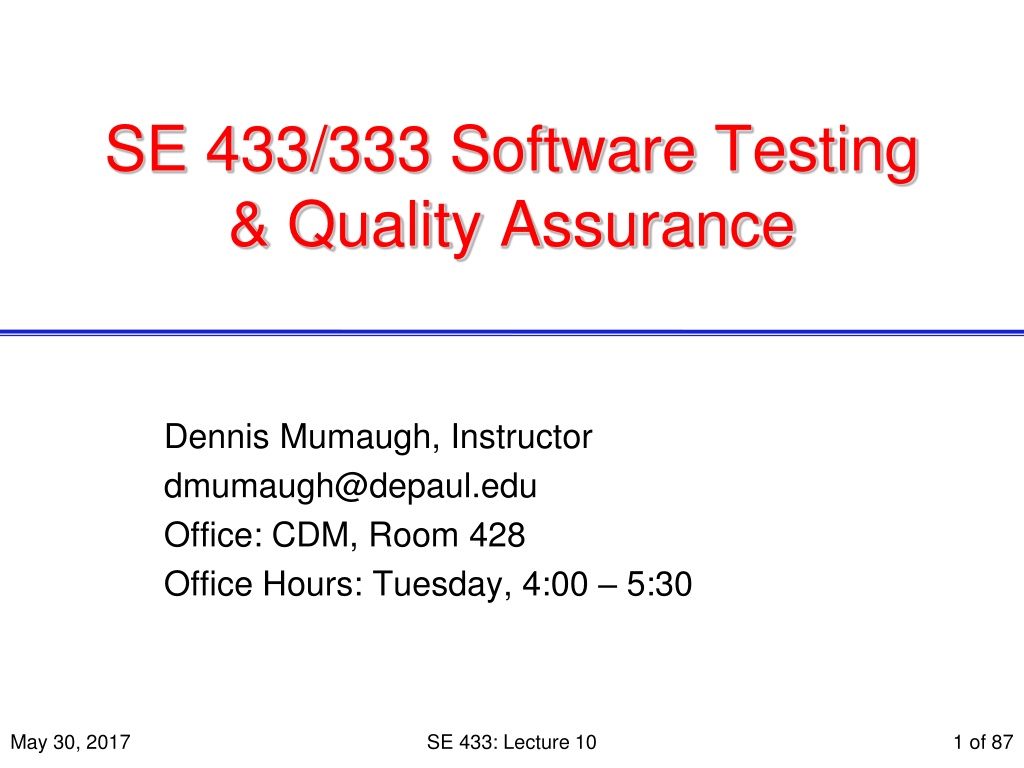
 undefined
undefined


